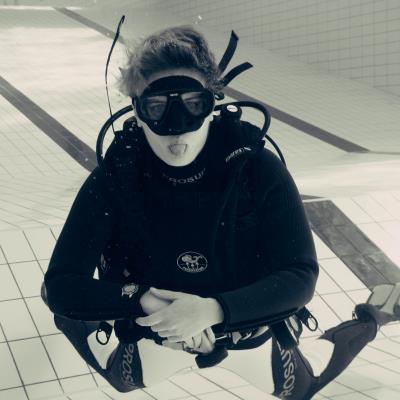Hard bottom - a highly coveted habitat
Compared to the widely extended areas of the soft bottom, the submarine hard bottom is – in terms of area - the smallest habitat. This habitat displays a big variety of structures and the typical organisms inhabiting these. The majority of animals living in this habitat are sessile, meaning they are attached to the ground and therefore at the mercy of the surrounding water conditions (especially concerning currents and light). Since the zones are very dependent on those conditions, one can hardly find any detailed information on preferred settling depths of benthic organisms in taxonomic identification literature. Close to the water surface one can find the spray zone and the intertidal zone.
Below that, the hard bottom can be divided into three groups, which can be recognized by the occurrence of different types of Gorgonians:
1) the upper hard bottom: White gorgonian (Eunicella singularis)
2) the intermediate hard bottom: Yellow gorgonian (Eunicella cavolini)
3) the lower hard bottom: Violescent gorgonian (Paramuricea clavata).
The upper hard bottom (upper Sublittoral) is mostly well-lit. Therefore one can find a pronounced Flora in form of red-, brown- and green algae. As light is also a limitation factor for unicellular algae, living in symbiosis with other species such as anemones (e.g. Anemona sulcata) and white gorgonians (Eunicella singularis), it influences the depth distribution of these species. The upper Sublittoral is also influenced by strong temperature fluctuations – organisms have to cope with temperatures between 8 -10°C in winter and up to 30°C in summer months. Furthermore, alternating and sometimes very strong currents in this zone affect body form, feeding habit and reproduction of the marine fauna. In order to sustain the currents, bodies are often rounded or flattened. In the upper Sublittoral upright growth forms (e.g. of corals such as Corallium rubrum) can only be found in caves and under overhangs where they are sheltered from the water movement. Surfaces to settle on are highly embattled in this habitat, no area remains unsettled. Noticeable here: sometimes organisms also settle on other organisms, acting as Epibionts. Sometimes, the actual animal can only hardly be recognized because it is totally overgrown by other organisms (e.g. Microcosmus spec.). Main feeding types in the upper Sublittoral are filter feeder (e.g. mussels, sea anemones and feather duster worms). In the intermediate hard bottom, currents become less distinct, but are still strong enough to provide sufficient water movement to supply nutrition and spreading eggs, sperms and larvae. Due to the decrease in light, the species composositon of algae shifts from green to brown algae. Animals with symbiotic algae (e.g. Eunicella singularis), are not represented anymore. Main feeding type in this zone are active filter feeding (e.g. sponges and bryozoans), where the animal is producing a current on its own. In the lower hard bottom, algae species are dominated by red alge, especially incrusting and calcifying species such as Lithothamnium spec.. Concerning sessile organisms, this zone is mainly dominated by sponges. In some species (e.g. Epinephelus marginatus, the Dusky Grouper), juveniles mainly live in the upper Sublittoral, whereas the adult organisms mostly withdraw to the deeper waters of the lower Sublittoral.


Load more comments